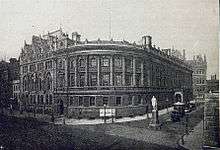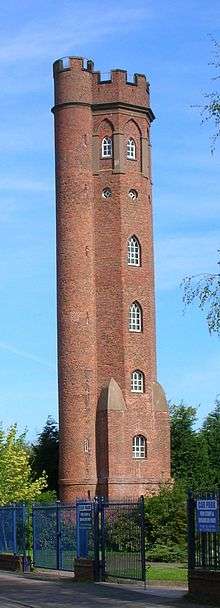Birmingham and Midland Institute


The Birmingham and Midland Institute (BMI) (grid reference SP066870), now on Margaret Street in the city centre of Birmingham, England was a pioneer of adult scientific and technical education (General Industrial, Commercial and Music) and today offers Arts and Science lectures, exhibitions and concerts. It is a registered charity. There is limited free access to the public, with further facilities available on a subscription basis.
History

Following the demise of the Birmingham Philosophical Institution, founded c.1800,[1] which was wound up in 1852, the BMI was founded in 1854 by Act of Parliament "for the Diffusion and Advancement of Science, Literature and Art amongst all Classes of Persons resident in Birmingham and the Midland Counties", as the Council had rejected the Free Libraries and Museums Act 1850. The BMI commissioned architect Edward Middleton Barry to design a building next to the Town Hall in Paradise Street. Half completed, in January 1860, the first public museum was opened in the BMI. Immediately the Council reversed its decision, and adopting the Act, negotiated with the BMI to buy the rest of the site. The other half of the planned building (up to Edmund Street) was completed by William Martin using the intended façade but redesigned behind. The municipal Public Library opened in 1866, but burned down during the building of an extension in 1879. Exhibitions of art were moved from the BMI to Aston Hall during rebuilding. In 1881 John Henry Chamberlain (architect and Honorary Secretary of the BMI) completed an extension to the Institute.
When its old building was demolished in 1965 as part of the redevelopment of the city centre the BMI moved to Margaret Street, the home of the private Birmingham Library, built in 1899 to the designs of architects Jethro Cossins, F. B. Peacock and Ernest Bewley, and now a Grade II* listed building.[2] A blue plaque on this building commemorates Albert Ketèlbey, who studied at the Birmingham School of Music when it was part of the Institute.
Charles Dickens was an early president after giving recitals in the Town Hall to raise funds. The BMI contains the 100,000 volumes of the Birmingham Library, founded in 1779.
In 1876, the subject Phonography was introduced to the BMI. During the first session, Marie Bethell Beauclerc, the first female shorthand reporter in England, taught 90 students. By 1891, there were over 300 students, predominately male, attending her Phonography classes.
A School of Metallurgy was set up in the BMI by G. H. Kenrick in 1875. This was spun-out from the BMI in 1895 as the Birmingham Municipal Technical School, now Aston University.[3]
Weather recording

In 1837 A. Follett Osler (Fellow of the Royal Society) gave a presentation on readings taken by a self-recording anemometer and rain gauge he had designed. He was funded by the Birmingham Philosophical Institution to design instruments and record meteorological data. He gave instruments to the BPI and BMI starting an almost unbroken record of weather measurements from 1869 (to 1954, date of source material). In 1884 the BMI leased Perrott's Folly, a 100-foot monument in Edgbaston, for use as an observatory. In 1886 the City of Birmingham Water Department allowed the BMI to erect instruments in an observatory on the nearby covered water reservoir. By 1923 a daily weather map was on display outside the Institute. The Observatory was still in operation in 1954 (date of source material). The Observatory received funding from the City Council, and the Air Ministry at various times.
Affiliated organisations
Various independent societies are affiliated to the BMI including:
- the Birmingham Philatelic Society, Moseley United Nations Association, Institute Ramblers, Birmingham and Warwickshire Archaeological Society, Alliance of Literary Societies, Birmingham Art Circle, Birmingham Water Colour Society, Midland Painting Group, Midland Spaceflight Society, Workers Educational Association, Dickens Fellowship, Olton Recorded Music Society, British Russian Society, the Birmingham and Midland Society for Genealogy and Heraldry, the Royal Institute of British Architects, Birmingham Film and Television Festival, Midland Co-operative Society and the Society for the History of Astronomy.
Presidents
- Baron Lyttelton of Hagley, (first President) 1854
- Charles Dickens, author (16th President) 1869
- Canon Charles Kingsley, author of Westward Ho! (1855) and The Water-Babies (1863). (19th President) 1872
- Edward White Benson, Archbishop of Canterbury (32nd) 1885
- Arthur Sullivan, (35th) 1888
- Charles Gore, 1st Bishop of Birmingham, (52nd) 1905
- Austen Chamberlain, (69th) 1923 Awarded the 1925 Nobel Peace Prize
- Sir H. Walford Davies, (86th President) 1940 Master of the King's Music
References
- ↑ Anon. (1830). An Historical and Descriptive Sketch of Birmingham, with some account of its environs, and forty-four views of the principal public buildings, etc. Birmingham: Beilby, Knott & Beilby. p. 185.
- ↑ Historic England, "Birmingham and Midland Institute (1343095)", National Heritage List for England, retrieved 5 October 2016
- ↑ "History and Traditions". Aston University. 2010. Retrieved 2010-08-09.
Sources
- All About Victoria Square, Joe Holyoak, The Victorian Society Birmingham Group, ISBN 0-901657-14-X
- Exploring Birmingham: A Guided Tour, Peter Groves, ISBN 1-869922-00-X
- By the Gains of Industry - Birmingham Museums and Art Gallery 1885-1985, Stuart Davies, ISBN 0-7093-0131-6
- The Birmingham and Midland Institute 1854-1954, Rachel E Waterhouse, 1954
- Birmingham City Council on BMI
- Birmingham Heritage on BMI
External links
Coordinates: 52°28′53″N 1°54′14″W / 52.4814°N 1.9038°W